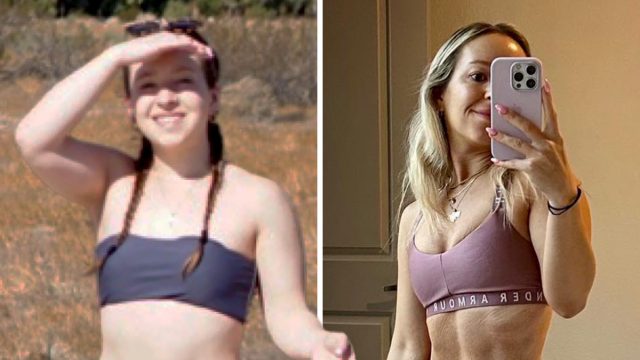I'm a Petite Nutritionist and These 6 Signs Show You're Actually Losing Weight
Are you in a calorie deficit? April Victoria Whitney is a nutritionist and influencer who helps petite women get into shape and lose pounds. In a new social media post, she discusses how weight loss is different for shorter women and the signs you are in a calorie deficit may differ from other people. "Are your calories right for petite fat loss?" she asks. "This is a question I get a lot from my petite clients trying to lose weight. As a petite person, you burn and require fewer calories. Dialing in the right balance of macros will be extra important for you to see results," she says, revealing "6 signs you're on the right track."
Your Hunger Level Is at 6 to 7 After a Meal
The first, "on a scale of 1-10 (1 being starving, and ten being stuffed), you should be at a 6-7 after a meal, and a 4-5 right before a meal," she says. "Slight hunger is normal before a meal! This is a good sign that your body is tapping into stored fat. Focus on PFF-balanced meals with 30g of protein minimum, + fat & fibrous carbs. If you're unsure, ask yourself if you'd eat a salad, and if the answer is no…you're probably not hungry."
You Are Seeing Small, Noticeable Changes in Fat Loss
If "you're seeing small noticeable change," you could be in a calorie deficit. "For healthy, sustainable fat loss as a petite, aim to lose about 0.5-1% of your body weight each week. For example, if you weigh 120 lbs, this translates to 0.6 to 1.2 lbs per week. The scale won't drop perfectly every week, so look for trends over a four-week span. Expecting to lose 5lbs in a week is a trap that always backfires, so aim for small changes," she writes.
Your Workouts Are "Challenging But Doable"
Next, "Your workouts are challenging but doable," she says. "It's common to feel a little less recovered between sessions, but you should still be able to slow down or modify to complete your workouts."
Your Mood and Energy Is Stable
If "your mood and energy is stable & you mostly feel like yourself," you could be burning calories. "If hangry, irritable, or constantly thinking about food, this could be a sign your calories are too low."
You Are Feeling Confident and Happy
Another sign? You are "feeling more confident and happy in your body," she says. "Mental and emotional shifts are powerful indicators of progress, too!"
RELATED: This Plan Is How to Lose 5 Percent Body Fat In 2 Weeks
You Are Less Bloated, and Your Stomach Is Flatter
A physical sign is that you are "less bloated" and have a "flatter stomach," she says. "As a petite, bloating can mask fat loss. If your digestion improves and you feel less bloated throughout the day, it's a sign your diet is working with your body, not against it."
Egg White & Spinach Wrap
In another post she reveals healthy high protein breakfast recipes for short girlies, "under 15 minutes, 30+ grams protein!" she writes, revealing some easy recipes, starting with an egg white and spinach wrap. It is made with 1 cup liquid egg whites, 1 cup fresh spinach, 1/4 cup low-fat shredded cheese, and 1 whole-wheat low carb tortilla and boasts over 30 grams of protein.
RELATED: I'm a Nutritionist and Here Are 19 Protein Truths You Need to Hear
Cumin & Turmeric Tofu Scramble
Next up a delicious scramble. Ingredients: 1/2 block firm tofu crumbled, 1 egg, olive oil spray, 1/2 cup diced tomatoes, 1/2 cup spinach, cumin & turmeric spices. The dish has over 30 grams of protein.
2-Ingredient Protein Pancakes
Her second recipe is protein pancakes, made with just two ingredients: two eggs and one banana. Add a side of one cup of nonfat Greek yogurt and half a cup of berries. The dish boasts a whopping 30 grams of protein.
High Protein Chia Pudding
Her next meal is high-protein chia pudding, made with 3/4 cup Greek yogurt, 1/2 cup milk of choice, 2 tablespoons chia seeds, 1 scoop protein powder, and 1/2 teaspoon vanilla extract. "Mix and let sit for 10 min. Fresh berries for topping," she says about the meal with 40 grams of protein.
RELATED: I Lost 42 Pounds with These 6 High-Protein Meals
Turkey & Cheese Omelette
The last meal she recommends is a turkey and cheese omelette, made with 2 large eggs, 1/4 cup diced turkey breast, 1/4 cup low-fat shredded cheese, 1/4 cup diced bell peppers, salt & pepper. The egg dish has 30 grams protein. And if you enjoyed this article, take advantage of these 15 Quick Ways to Lose Body Fat Percentage in a Week.





